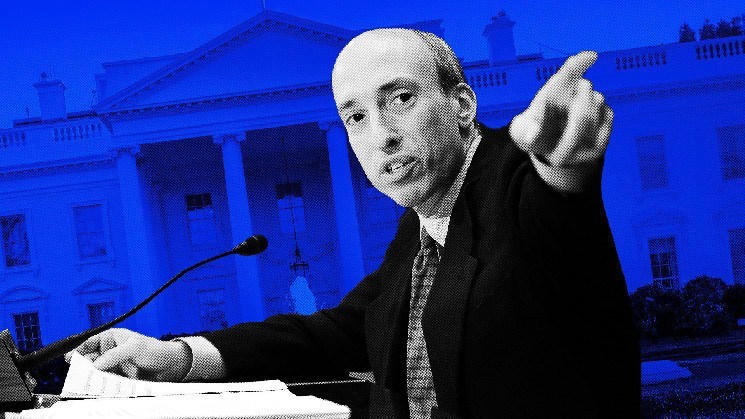Proof of security? Gensler eyes proof of stake after The Merge

Ethereum’s successful shift from proof of work to proof of stake was a public relations win for the cryptocurrency thanks to dramatically shrinking the network’s energy consumption.
But the most influential markets regulator in the world suggested the code shift could have an unintended consequence that would disrupt the world’s second-largest cryptocurrency and likely reverberate through digital asset markets.
Securities and Exchange Commission Chair Gary Gensler raised eyebrows last week when he hinted that the commission could classify tokens in proof of stake networks as securities. While Gensler did not specifically mention ether, according to multiple reports, the question was asked on the same day developers shifted ether’s blockchain from proof of work to proof of stake in an event called The Merge.
If ether were designated a security, it would effectively reverse unofficial guidance towards the token that the SEC gave four years ago. And it would come with a whole host of reporting requirements for transactions that could throw the cryptocurrency into chaos, as well as broader digital asset markets.
Gensler told reporters that a digital asset switching its network validation could be classified as a security because “the investing public is anticipating profits based on the efforts of others.” The SEC chief made the remarks after an appearance before the Senate Banking Committee last week. The SEC did not respond to a request for additional comment.
Cryptocurrency advocates responded with disbelief.
“The false premise that proof of stake tokens are securities because of the way that transactions are validated on the protocol, quite frankly, shows the need for more education and more common-sense and pro-innovation crypto regulations and laws,” said Alison Smith Mangiero, the acting head of the Proof of Stake Alliance, an industry group. Mangiero called the Howey test, the main legal standard by which assets are classified as securities, “antiquated” and said Gensler’s interpretation of how it applies to proof of stake is «overly broad.”
Coin Center Research Director Peter Van Valkenburgh agreed that the securities standard should not apply to ether, disputing Gensler’s application of the legal standard to staking.
“I do not think that anything about the choice of whether to use a proof of work consensus mechanism internal to a protocol versus proof of stake has any real bearing on the relationship between an owner or investor and promoter or more persons maintaining the network,” said Van Valkenburgh. It also isn’t clear to digital asset developers where the SEC stands on public remarks from a former official, Van Valkenburgh said. Several years ago, former Director of Corporation Finance William Hinman said he viewed bitcoin and ether as outside the traditional designation of a security due to their decentralized networks.
“The SEC doesn’t seem interested in general about doing these public rulemakings about crypto policy. They seem content to have sort of vague guidance,” Van Valkenburgh said. “Does the newer vague guidance override the old bit of guidance? They’re not clear about it. And that is a big part of the problem.”
Others in the financial policy world say Gensler’s statement is justified. Because Ethereum’s code shift was decided by humans with a financial stake, the cryptocurrency looks like a security, argued Tyler Gellasch, the president and CEO of the Healthy Markets Association and a one-time staffer to former Democratic SEC Commissioner Kara Stein.
“It’s a very obvious example of the asset fundamentally changing based on the decisions of human beings, and the valuation of that asset and performance of that asset changing in a very fundamental way,” Gellasch said. “The value of the asset has changed, based on the decisions of the people that are controlling the asset itself.”
Since the SEC began actively enforcing securities laws around blockchain projects during the ‘Initial Coin Offering’ boom of 2017, cryptocurrency supporters have pushed for their assets to be considered commodities, or decentralized ‘utility’ tokens that would fall outside of the paperwork requirements and more stringent regulation that comes with being considered a security. Hinman’s 2018 speech, and similar remarks from then-SEC Chair Jay Clayton about tokens reaching a point of utility, rather than being a pure financial instrument, seemed to classify ether in one of those categories rather than as a security.
But Gellasch dismissed the argument that ether could be a commodity, noting ether’s properties changed to reduce environmental impact.
“A slab of aluminum doesn’t do that,” he said.






 Bitcoin
Bitcoin  Ethereum
Ethereum  Tether
Tether  USDC
USDC  TRON
TRON  Dogecoin
Dogecoin  Cardano
Cardano  Bitcoin Cash
Bitcoin Cash  Chainlink
Chainlink  Monero
Monero  LEO Token
LEO Token  Stellar
Stellar  Zcash
Zcash  Litecoin
Litecoin  Hedera
Hedera  Dai
Dai  Cronos
Cronos  Tether Gold
Tether Gold  OKB
OKB  Ethereum Classic
Ethereum Classic  KuCoin
KuCoin  Gate
Gate  Algorand
Algorand  Cosmos Hub
Cosmos Hub  VeChain
VeChain  TrueUSD
TrueUSD  Tezos
Tezos  Dash
Dash  Stacks
Stacks  IOTA
IOTA  Basic Attention
Basic Attention  Theta Network
Theta Network  Decred
Decred  NEO
NEO  Synthetix
Synthetix  Qtum
Qtum  Ravencoin
Ravencoin  DigiByte
DigiByte  0x Protocol
0x Protocol  Nano
Nano  Zilliqa
Zilliqa  Siacoin
Siacoin  Numeraire
Numeraire  Waves
Waves  BUSD
BUSD  Status
Status  Pax Dollar
Pax Dollar  Enjin Coin
Enjin Coin  Ontology
Ontology  Hive
Hive  Lisk
Lisk  Steem
Steem  Huobi
Huobi  NEM
NEM  OMG Network
OMG Network  Bitcoin Gold
Bitcoin Gold  Augur
Augur  Ren
Ren  HUSD
HUSD